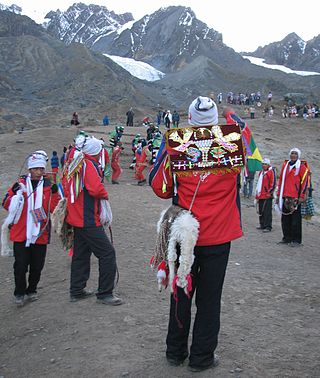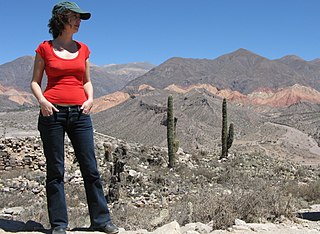Related Research Articles

Cusco or Cuzco is a city in southeastern Peru near the Urubamba Valley of the Andes mountain range. It is the capital of the Cusco Region and of the Cusco Province. The city is the seventh most populous in Peru; in 2017, it had a population of 428,450. Its elevation is around 3,400 m (11,200 ft).

Martín Chambi Jiménez was a Peruvian photographer, originally from Puno, in southern Peru. He was one of the first major Indigenous Latin American photographers.

The Urubamba River or Vilcamayo River is a river in Peru. Upstream it is called Vilcanota River. Within the La Convención Province, the name changes to Urubamba. A partially navigable headwater of the Amazon River, the Urubamba rises in the Andes to the southeast of Cusco. It originates on the slopes of Cunurana in the Puno Region, Melgar Province, near the La Raya pass. It flows north-north-west for 724 km (450 mi) before coalescing with the Tambo River to form the Ucayali River.

Písac or Pisac is a Peruvian town in the Sacred Valley of the Incas. It is situated on the Vilcanota River. Pisac is most known for its Incan ruins and large market which attracts heavy tourist traffic from nearby Cusco.

La Convención Province is the largest of thirteen provinces in the Cusco Region in the southern highlands of Peru.

The Cusco School or Cuzco School, was a Roman Catholic artistic tradition based in Cusco, Peru during the Colonial period, in the 16th, 17th and 18th centuries. It was not limited to Cusco only, but spread to other cities in the Andes, as well as to present day Ecuador and Bolivia.

Quyllurit'i or Qoyllur Rit'i is a syncretic religious festival held annually at the Sinakara Valley in the southern highlands Cusco Region of Peru. Local indigenous people of the Andes know this festival as a native celebration of the stars. In particular they celebrate the reappearance of the Pleiades constellation, known in Quechua as Qullqa, or "storehouse," and associated with the upcoming harvest and New Year. The Pleiades disappears from view in April and reappears in June. The new year is marked by indigenous people of the Southern Hemisphere on the Winter Solstice in June, and it is also a Catholic festival. The people have celebrated this period of time for hundreds if not thousands of years. The pilgrimage and associated festival was inscribed in 2011 on the UNESCO Intangible Cultural Heritage Lists.

The Andahuaylillas District is one of the twelve districts in the Quispicanchi Province in Peru. Created on January 2, 1857, its capital is the town of Andahuaylillas. It is located 45 km South of Cusco. Andahuaylillas is one of the main stages of the Andean Baroque Route along with Cusco, Huaro and Urcos.

The Lucre District is one of the twelve districts in the Quispicanchi Province in Peru. Created by Law No. 9295 on January 17, 1941, its capital is the town of Lucre.

The Urcos District is one of the twelve districts in the Quispicanchi Province in Peru. Created on January 2, 1857, its capital is the town of Urcos. Urcos is southeast of the former Inca capital, Cusco, in the southern Andes, and it is at an altitude of 3,180 meters (10,430 ft).
The Wayqecha Biological Station is a tropical ecological research station near Peru's Manú National Park. This research station is located in the upper reaches of the river Cosñipata, an affluent of the Madre de Dios River, in the Paucartambo Province, Cusco Region. The station ranges from 2200 to 3700 m in elevation and includes several Andean ecosystems, such as montane forests, elfin forests, montane scrub and high-Andean grassland (puna). These ecosystems are connected by a series of trails and by the road Paucartambo-Shintuya. The station was established in 2005 and is managed by two non-governmental organizations: the Peruvian NGO Asociación para la Conservación de la Cuenca Amazónica (ACCA) and the US-based Amazon Conservation Association (ACA), which also manages the Los Amigos Biological Station in the lowland rainforest of southeastern Peru.

Coya District is one of eight districts of the Calca Province in the Cusco Region of Peru.

Since the 2000s, Tourism in Peru makes up the nation's third largest industry, behind fishing and mining. Tourism is directed towards archaeological monuments, ecotourism in the Peruvian Amazon, cultural tourism in colonial cities, gastronomic tourism, adventure tourism, and beach tourism. According to a Peruvian government study, the satisfaction rate for tourists after visiting Peru is 94%. Tourism is the most rapidly growing industry in Peru, growing annually at a rate of 25% over the past five years. Tourism is growing in Peru faster than any other country in South America. Iperú is the Peruvian national tourist office.

Puka Pukara is a site of military ruins in Peru situated in the Cusco Region, Cusco Province, Cusco District, near Cusco. This fort is made of large walls, terraces, and staircases and was part of defense of Cusco in particular and the Inca Empire in general.

Pachamama is a goddess revered by the indigenous peoples of the Andes. In Inca mythology she is an "Earth Mother" type goddess, and a fertility goddess who presides over planting and harvesting, embodies the mountains, and causes earthquakes. She is also an ever-present and independent deity who has her own creative power to sustain life on this earth. Her shrines are hallowed rocks, or the boles of legendary trees, and her artists envision her as an adult female bearing harvests of potatoes or coca leaves. The four cosmological Quechua principles – Water, Earth, Sun, and Moon – claim Pachamama as their prime origin. Priests sacrifice offerings of llamas, cuy, and elaborate, miniature, burned garments to her. Pachamama is the mother of Inti the sun god, and Mama Killa the moon goddess. Mama Killa is said to be the wife of Inti.

Jolljepunco, Colquepunco or Sasahui (sasawi) local name for Leucheria daucifolia, -ni an Aymara suffix to indicate ownership, "the one with the sasawi plant", Hispanicized Sasahuini) is a mountain in the Andes of Peru and the name of a lake near the peak. The mountain is about 5,522 metres (18,117 ft) high. It is situated in the northern extensions of the Vilcanota mountain range in the Cusco Region, Quispicanchi Province, in the districts Ccarhuayo and Ocongate and in the Paucartambo Province, Kosñipata District. Jolljepunco lies northwest of the lake Singrenacocha, southeast of Minasnioc. The lake named Jolljepunco is situated south of the mountain at 13°32′04″S71°12′29″W.

Ina Vandebroek is an ethnobotanist working in the areas of floristics, ethnobotany and community health. Since 2005, she has worked at the New York Botanical Garden in the Institute of Economic Botany. She has worked on ethnobotanical projects in North America, the Caribbean, and South America.

Ocra is a Quechuan Campesino community within the Chinchaypujio District in Peru and about 1.5 hours outside of Cusco; its central village is located at 3,670 m (12,040 ft) altitude.

The Basilica of La Merced, also known as Convent of La Merced, is a minor basilica located in the city of Cusco, Peru. It is located 100 meters southwest of the Plaza de Armas in front of the Plazoleta Espinar. It belongs to the Order of the Blessed Virgin Mary of Mercy and has, annexes, both the convent and the premises of La Merced College. The church has a three-nave basilica plan covered with brick vaults and dome on the crossing, with Baroque altars on its lateral naves and Neoclassical style on the main altar. It also has a tower with Baroque bell tower topped with a semicircular dome. Highlights its portal-side reredos and the Renaissance portal of the muro de pies, the choir stalls, its colonial paintings and polychrome wood carvings. Inside rest the remains of Diego de Almagro, Diego de Almagro II and Gonzalo Pizarro.

The Convent of Santo Domingo is a convent of the Dominican Order in the city of Cusco, Peru. Spanish colonists built it on top of Coricancha, the most important Inca temple of the capital of the people's empire.
References
- ↑ "Museo de Plantas Sagradas: Review". Fodor's Travel Intelligence. Retrieved 27 May 2013.
- ↑ "TripAdvisor Cusco: Museums & Attractions". TripAdvisor - Cusco: Museums & Attractions. Retrieved 27 May 2013.